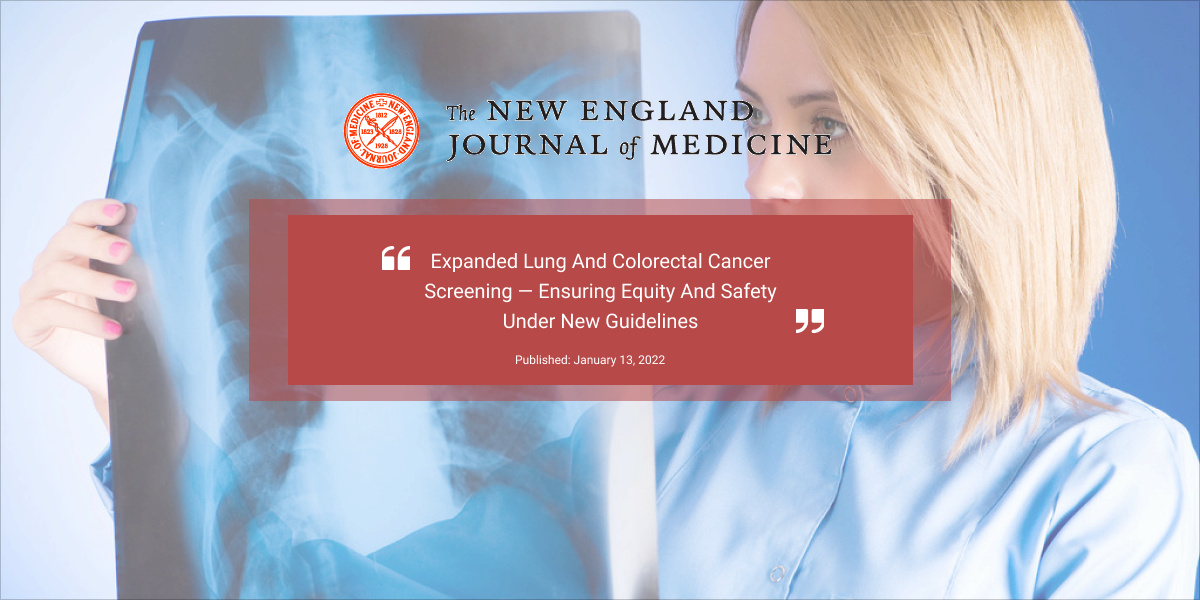Expanded Lung and Colorectal Cancer Screening — Ensuring Equity and Safety under New Guidelines

Expanded Lung and Colorectal Cancer Screening — Ensuring Equity and Safety under New Guidelines
In 2021, the U.S. Preventive Services Task Force (USPSTF) recommended major expansions of the populations that should undergo routine screening for lung or colorectal cancer. Both recommendations are evidence-based and, if implemented effectively, will most likely save lives. The changes were made with an eye toward reducing inequities in rates of early cancer detection among women and people who identify as Black, Indigenous, or Latinx. The guidelines, however, were released without adequate attention to how they would be implemented. Efforts to deploy complex, highly personalized screening methods using the patchwork approach that is typical of the U.S. health system could backfire, unless health care organizations, payers, and policymakers invest in preventive care infrastructure.
We believe regulatory and policy solutions are necessary to prevent unintended consequences associated with these important expansions in cancer-screening eligibility. To combat systemic racism and promote safety in ambulatory care, health care systems could collect and report data on disparities in preventive care, and they could design and deploy safety nets to ensure timely follow-up after abnormal screening results. In addition, we need policies that explicitly support equity and safety in preventive care.
When layered atop an already inequitable care delivery system, a substantial increase in the volume of preventive screening could exacerbate inequities in access based on race and other factors and lead to missed or delayed cancer diagnoses because of inadequate follow-up. Twenty million people between 45 and 49 years of age are newly eligible for routine colorectal cancer screening under the guidelines. Another 6.4 million people are newly eligible for lung cancer screening. The recommended age for starting lung cancer screening in current or former smokers dropped from 55 to 50 years, and the recommended number of pack-years of smoking history before screening is initiated dropped from 30 to 20 — which nearly doubles the population of eligible adults.1
Even before these changes, the preventive care system wasn’t functioning well. Under the previous USPSTF screening guidelines, only 5% of eligible people received lung cancer screening, and 69% of adults were up to date for colorectal cancer screening. Eligible populations now include younger people, who have historically had lower preventive-screening rates, are more racially and ethnically diverse, and are more likely to be underinsured than older people. Inequities in screening rates, cancer incidence, and mortality have persisted for decades, in part because health care systems haven’t invested in preventing systemic racism in the delivery of routine preventive care and don’t have functional systems to consistently follow up after test results indicating moderate or high cancer risk.2 Purposeful action will be required to overcome these challenges to meet the goals of the expanded USPSTF guidelines.
We believe the first step is for health care systems to create equity dashboards that report data on disparities in screening rates by race and ethnic group, sexual orientation and gender identity, and language. Because we can’t improve what we don’t measure, equity dashboards tracking key process and outcome measures should become part of the standard performance-management tools deployed throughout the U.S. health system. Our perspective could then shift from caring for only the individual patients who come into our offices to having a more complete understanding of the health of our populations, so that we can begin to systematically address the barriers our patients experience and promote the facilitators our patients need. Such an approach is critical to delivering on the potential of the new guidelines, and it will be required to begin addressing systemic racism and other inequities in our health care systems. Of course, reliable equity dashboards will not be possible unless health systems consistently ask patients to share key demographic data. This will require proactive education and outreach in close partnership with the community, as demonstrated in the “We Ask Because We Care” campaigns deployed by numerous U.S. health systems over the past decade.
Plans to address inequities in preventive care could be mandated by the Joint Commission, the National Committee for Quality Assurance, and other credentialing bodies. Health care systems will then need to focus on solutions for advancing equity, such as employing preventive care navigators, offering after-hours screening and diagnostic services to enhance access, supporting community-based screening sites, and broadly deploying programs offering home-based screening methods, such as fecal immunochemical testing or fecal DNA testing for colorectal cancer. By setting explicit goals regarding equitable access to preventive care and tracking improvement, we can avoid exacerbating health disparities and begin leveraging the USPSTF guidelines to correct long-standing inequities.
As health care systems reap the financial rewards of conducting the various diagnostic evaluations and surveillance tests that frequently follow screening, they could also be mandated to invest in a comprehensive cancer-screening safety-net program. Such a program could include registries and workflows to ensure that follow-up of abnormal test results is completed in a timely and highly reliable manner for all patients. Very few programs for colorectal cancer screening in the United States have a high-reliability system to track all patients who don’t follow up after an abnormal screening result. Although accredited facilities for lung cancer screening that bill Medicare are required to submit data to the Centers for Medicare and Medicaid Services using a registry, there’s no requirement that the registry then be employed to close the loop and ensure that follow-up occurs. An ideal cancer-screening safety-net program would track all patients for various preventive services, regardless of insurance status.
The goal of implementing equitable and safe cancer screening throughout the population will be difficult to achieve without payment and regulatory reform. Several types of reform would be beneficial. First, payers could recognize the role of health navigators as crucial members of the care team. Once navigators are funded, either by means of a fee-schedule adjustment or as part of a primary care subcapitation model, they could engage with the most marginalized patients in their communities to address social barriers to care, facilitate shared decision making, and order and schedule indicated tests. Navigators would also manage cancer-screening safety-net registries and perform patient outreach.
Second, the United States lacks the type of well-organized national screening program that has been adopted in many European countries.3 To address this gap, the federal government and state governments could enter into collaborative agreements with health care organizations to establish interoperable preventive care and safety-net registries that would allow the preventive-screening records of patients who move from one health care system or geographic region to another to be readily accessible to any clinician they see. Third, mandating that employers provide paid leave for preventive care is key to ensuring uptake among the younger populations that are included in the expanded USPSTF guidelines.4
Fourth, Congress could pass legislation that compels both commercial and government payers to immediately cover services that receive grade A or B recommendations from the USPSTF. The current 1-year lag before commercial payers must begin reimbursing providers for recommended services delays screening uptake and could therefore delay the diagnosis of new cancers. Finally, Medicaid expansion under the Affordable Care Act has driven substantial improvement in the provision of preventive care. We believe all efforts should be made to induce the 12 states that haven’t yet expanded Medicaid to do so.5
The expansion of eligibility for lung and colorectal cancer screening outlined by the USPSTF represents an opportunity for the United States to promote health equity, create safety-net registries to ensure adequate follow-up after screening, and implement regulatory and payment reform that facilitates rapid adoption of these and other preventive care guidelines. Given that we are building on a shaky foundation, all policy and regulatory levers should be pulled to generate incentives for the U.S. health system to invest in a more equitable and safer approach to preventive care.
![]() Daniel M. Horn, M.D., and Jennifer S. Haas, M.D.
Daniel M. Horn, M.D., and Jennifer S. Haas, M.D.
This article was published on January 8, 2022, at NEJM.org.

